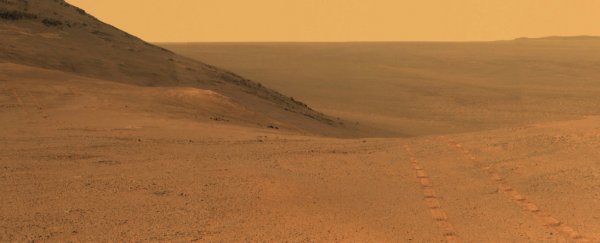It's been almost two months since NASA last heard from the Mars Opportunity rover, and things are not looking good.
Ever since the Red Planet became engulfed in an intense and enormous dust storm, the rover team has been trying desperately to contact their precious vehicle.
Three times a week, every week since June 10, they have been sending out a signal and hoping for a response beep from the little rover.
So far they have only been met with silence.
Now, as the storm begins to abate and the Martian skies are starting to clear, engineers at NASA's Jet Propulsion Laboratory (JPL) are hoping that contact can at last be made.
"The dust haze produced by the Martian global dust storm of 2018 is one of the most extensive on record, but all indications are it is finally coming to a close," said one of the project scientists, Rich Zurek.
"MARCI images of the Opportunity site have shown no active dust storms for some time within 3,000 kilometers [about 1,900 miles] of the rover site".
The current health of the rover, which put itself to sleep halfway down Mars's Perseverance Valley, remains unknown. With the steady return of sunlight, NASA has a plan to figure out what is going on.
"The Sun is breaking through the haze over Perseverance Valley, and soon there will be enough sunlight present that Opportunity should be able to recharge its batteries," said John Callas, the Opportunity project manager at JPL.
"When the tau level [a measure of the amount of particulate matter in the Martian sky] dips below 1.5, we will begin a period of actively attempting to communicate with the rover by sending it commands via the antennas of NASA's Deep Space Network.
"Assuming that we hear back from Opportunity, we will begin the process of discerning its status and bringing it back online".
Still, even if Opportunity has the chance to phone home, the odds are not in its favour.
When you're a robotic vehicle that runs almost entirely on solar energy, a planet-encircling dust storm can be a kiss of death. And the nearly 15-year-old rover is no spring chicken.
The latest dust storm is one of the largest ever observed on Mars, and it could have permanently reduced the rover's ability to produce energy, store energy, and return online once again.
As a result, NASA has committed to giving the rover and its hard-working team a final deadline.
"If we do not hear back after 45 days, the team will be forced to conclude that the Sun-blocking dust and the Martian cold have conspired to cause some type of fault from which the rover will more than likely not recover," said Callas.
"At that point our active phase of reaching out to Opportunity will be at an end.
"However, in the unlikely chance that there is a large amount of dust sitting on the solar arrays that is blocking the Sun's energy, we will continue passive listening efforts for several months".
But not everyone agrees with this plan. The former Opportunity flight director Mike Seibert has called the strategy "100% Grade A B.S." on Twitter.
Opportunity is equipped with two 'wings' of solar panels, both of which provide it with enough energy to explore the dusty planet and communicate with Earth.
If these panels are blanketed by dust from the settling storm, there is a chance, however slim, that a bout of wind - called a "dust devil" - could clean them off.
As Seibert points out, however, the dust devil season usually starts in November, and that is well past the allotted 45 days. In light of this information, he argues instead that active listening should continue until the dust devil season has officially come and gone.
Nevertheless, NASA says it's doubtful that a film of dust is the root cause of the rover's radio silence.
Even though the Opportunity team isn't holding their breath, they are remaining cautiously optimistic. After all, this isn't the first time that Opportunity has exceeded their expectations.
When the rover was first sent to Mars, it was only expected to last 90 days. Today, despite losing its front steering and its flash memory function, the rover has continued to soldier on, well beyond its warranty period.
In 2007, Opportunity was even able to survive a similar dust storm that encircled the planet for two weeks and blocked 99 percent of all sunlight.
Against all odds, the persistent rover has now been exploring Mars for well over 5,000 days, travelling more than 45 kilometres (28 miles).
"In a situation like this you hope for the best but plan for all eventualities," said Callas.
"We are pulling for our tenacious rover to pull her feet from the fire one more time. And if she does, we will be there to hear her".
The Curiosity rover, which doesn't rely on solar panels, remains in good health on Mars.
Updates on the dust storm can be found here.
